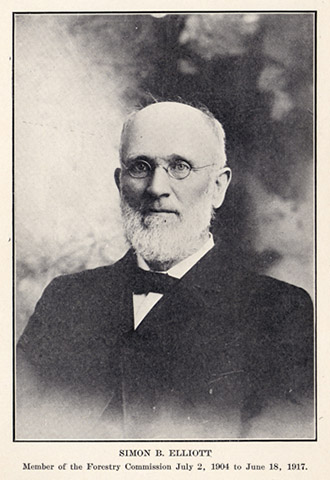History of Simon B. Elliott State Park
This mountaintop was once covered in giant white pine and hemlock trees. At the turn of the century, the Central Pennsylvania Lumber Company and the Goodyear Lumber Company built railroads and roads to harvest the timber.
This logging devastated the area, entirely wiping out the magnificent stands of pine and hemlock. The swift departure of the logging companies allowed the barren forests to regrow. This devastated land was eventually sold to the commonwealth, usually at tax sales, and later became Moshannon State Forest.
Now about a century later, many of the logging roads and railroad grades can be seen in the maturing stands of oak and maple.

The Honorable Simon B. Elliott was a member of the Pennsylvania Legislature and a member of the old State Forestry Reservation Commission, a precursor to the Department of Forestry. This early conservationist promoted the idea of creating a nursery to raise trees for planting in the surrounding area.
During 1911, the Commonwealth of Pennsylvania established the Clearfield Forest Tree Nursery in a mountain pasture atop Penfield Mountain. This nursery was later renamed for District Forester William F. Dague who was in charge of its operation from its start in 1911 until 1947.
The Dague Nursery closed in 1978, but its buildings and facilities are still in use as the Moshannon State Forest maintenance headquarters, and the seed orchards still supply seeds for the other state nurseries.
Civilian Conservation Corps
During 1933, the Civilian Conservation Corps (CCC) established Camp S-116 on land along the edge of the nursery and built the cabins, pavilions, roads, trails, and many of the other buildings that exist today in the park.
During that same year, 1933, the former Department of Forests and Waters erected a plaque dedicating Simon B. Elliott State Park. The plaque is on a stone in the pines along the northern edge of the park.